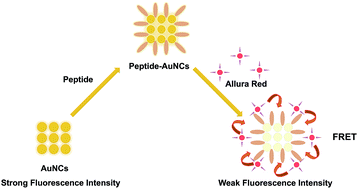Peptide modified gold nanoclusters as a novel fluorescence detector based on quenching system of detecting Allura red†
Abstract
In this paper, a novel nanocomposite fluorescence detector that was synthesized from gold nanoclusters (AuNCs) and a ten-amino acid peptide CCYRGHDHCY was successfully generated for the determination of Allura red (AR) for the first time. Allura red can quench the fluorescence of AuNCs via the Forster resonance energy transfer (FRET) mechanism. Upon addition of Allura red, the red fluorescence intensity of peptide–AuNCs was dramatically quenched and had a linear relationship over the range of 2–90 μM of Allura red with high sensitivity. The results show that the detection limit is 0.667 μmol L−1 (S/N = 3), and the correlation coefficient of the standard curve is 0.998. Compared to the cumbersome and difficult operation of paper chromatography for the detection of Allura red, this method is simple to use and has a high recovery rate and good stability. Moreover, this proposed peptide–AuNCs fluorescence detector has the potential to be used for detecting Allura red in real samples with accurate results.



 Please wait while we load your content...
Please wait while we load your content...